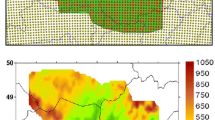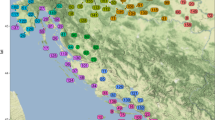Abstract.
In this study we set out to investigate the possibility of linking phenological phases throughout the vegetation cycle, as a local-scale biological phenomenon, directly with large-scale atmospheric variables via two different empirical downscaling techniques. In recent years a number of methods have been developed to transfer atmospheric information at coarse General Circulation Model's grid resolutions to local scales and individual points. Here multiple linear regression (MLR) and canonical correlation analysis (CCA) have been selected as downscaling methods. Different validation experiments (e.g. temporal cross-validation, split-sample tests) are used to test the performance of both approaches and compare them for time series of 17 phenological phases and air temperatures from Central Europe as microscale variables. A number of atmospheric variables over the North Atlantic and Europe are utilized as macroscale predictors. The period considered is 1951–1998. Temporal cross-validation reveals that the CCA model generally performs better than MLR, which explains 20%–50% of the phenological variances, whereas the CCA model shows a range from 40% to over 60% throughout most of the vegetation cycle. To show the validity of employing phenological observations for downscaling purposes both methods (MLR and CCA) are also applied to gridded local air temperature time series over Central Europe. In this case there is no obvious superiority of the CCA model over the MLR model. Both models show explained variances from 40% to over 70% in the temporal cross-validation experiment. The results of this study indicate that time series of phenological occurrence dates are very compatible with the needs of empirical downscaling originally developed of local-scale atmospheric variables.










Similar content being viewed by others
References
Böhm R, Auer I, Brunetti M, Maugeri M, Nanni T, Schöner W (2001) Regional temperature variability in the European Alps: 1760–1998 from homogenized instrumental time series. Int J Climatol 21:1779–1801
Bolliger J, Kienast F, Zimmermann NE (2000) Risks of global warming on monate and subalpine forests in Switzerland – a modeling study. Reg Environ Change 1:99–111
Busuioc A, Storch H von (1996) Changes in the winter precipitation in Romania and its relation to the large-scale circulation. Tellus 48A:538–552
Chmielewski FM, Rötzer T (2001) Response of tree phenology to climate change across Europe. Agric For Meteorol 108:101–112
Fyfe JC, Boer GJ, Flato GM (1999) The Arctic and Antarctic Oscillations and their projected changes under global warming. Geophys Res Lett 26:1601–1604
Gyalistras D, Storch H von, Fischlin A, Beniston M (1994) Linking GCM-simulated climatic changes to ecosystem models: case studies of statistical downscaling in the Alps. Clim Res 4:167–189
Hewitson B, Crane R (1992) Regional climate prediction from the GISS GCM. Palaeogeogr Palaeoclimatol Palaeoecol 97:249–267
Heyen H, Fock H, Greve W (1998) Detecting relationships between the interannual variability in ecological timeseries and climate using a multivariate statistical approach – case study for Helgoland Roads zooplankton. Clim Res 10:179–191
Jones PO, Jonsson T, Wheeler D (1997) Extension to the North Atlantic Oscillation using early instrumental pressure observations from Gibraltar and South-West Iceland. Int J Climatol 17:1433–1450
Kalnay E, Kanamitsu M, Kistler R, Collins W, Deaven D, Gandin L, Iredell M, Saha S, White G, Woollen J, Zhu Y, Chelliah M, Ebisuzaki W, Higgins W, Janowiak J, Mo KC, Ropelewski C, Wang J, Leetmaa A, Reynolds R, Jenne R, Joseph D (1996) The NCEP/NCAR reanalysis project. Bull Am Meteorl Soc 77:437–471
Kröncke I, Dippner JW, Heyen H, Zeiss B (1998) Long-term changes in macrofauna communities of Norderney (East Frisia, Germany) in relation to climate variability. Mar Ecol Prog Ser 167:25–36
Lexer MJ, Hönninger K, Scheifinger H, Matulla C, Groll N, Kromp-Kolb H, Schaudauer K, Starlinger F, Englisch M (2002) The sensitivity of Austrian forests to scenarios of climate change: a large-scale risk assesment based on a modified gap model and forest inventory data. For Ecol Manage 162: 53–72
Maak K, Storch H von (1997) Statistical downscaling of monthly mean air temperature to the beginning of flowering of Galanthus nivalis L. in Northern Germany. Int J Biometeorol 41:5–12
Matulla C, Groll N, Kromp-Kolb H, Scheifinger H, Lexer MJ, Widmann M (2002) Climate change scenarios at Austrian National Forest Inventory sites. Clim Res 22:161–173
Menzel A (1997) Phänologie von Waldbäumen unter sich ändernden Klimabedingungen. Auswertung der Beobachtungen in den Internationalen Phänologischen Gärten und Möglichkeiten der Modellierung von Phänodaten. Forstliche Forschungsberichte 164, Forstwissenschaftliche Fakultät der Universität München und der Bayerischen Landesanstalt für Wald- und Forstwirtschaft
Menzel A (2002) Phenology: its importance to the global change community. Clim Change 54:379–385
Osborne CP, Chuine I, Viner D, Woodward FI (2000) Olive phenology as a sensitive indicator of future climatic warming in the Mediterranean. Plant Cell Environ 23:701–710
Ottersen G, Planque B, Belgrano A, Post E, Reid PC, Stenseth NC (2001) Ecological effects of the North Atlantic Oscillation. Oecologia 128:1–14
Post E, Stenseth NC (1999) Climatic variability, plant phenology, and northern ungulates. Ecology 80:1322–1399
Price DT, Zimmermann NE, Meer PJ van der, Lexer MJ, Leadley P, Jorritsma ITM, Schaber J, Clark DF, Lasch P, McNulty S, Wu J, Smith B (2001) Regeneration in gap models: priority issues for studying forest responses to climate change. Clim Change 51:475–508
Scheifinger H, Menzel A, Koch E, Peter C, Ahas R (2002) Atmospheric mechanisms governing the spatial and temporal variability of phenological observations in Central Europe. Int J Climatol 22:1739–1755
Straile D (2002) North Atlantic Oscillation synchronizes food-web interactions in Central European lakes. Proc R Soc Lond 269:391–395
Storch H von, Hannoschöck G (1985) Statistical aspects of estimated principal vectors (EOFs) based on small sample sizes. J Clim Appl Meteorol 24:716–724
Storch H von, Hewitson B, Mearns L (2000) Review of empirical downscaling techniques. In: Iversen T, Hoiskar B (eds) Regional climate development under global warming. General Technical Report 4. In: Proceedings of the Reg Clim Spring Meeting. Jevnaker, Torbjornrud, pp 29–46
Storch H von, Zwiers F (1999) Statistical analysis in climate research. Cambridge University Press
Storch H von, Zorita E, Cubasch U (1993) Downscaling of global climate change estimates to regional scales: an application to Iberian rainfall in wintertime. J Clim 6:1161–1171
Acknowledgements
This study was funded by the 5th Framework Programme of the European Commission under the key action Global Change, Climate and Biodiversity (POSITIVE, EVK2-CT-1999-00012) and by the Austrian Federal Ministry of Education, Science and Culture within the research project: "Usability of different downscaling methods in complex terrain". MeteoSwiss, the German Weather Service and the Hydrometeorological Service of Slovenia are thanked for providing phenological observations. The Austrian Weather Service provided the ALPCLIM dataset. We would like to thank H. Matulla, S. Wagner and D. Bray for fruitful discussions and for helping us with the manuscript. The manuscript was improved by the comments of two anonymous referees.
Author information
Authors and Affiliations
Corresponding author
Rights and permissions
About this article
Cite this article
Matulla, C., Scheifinger, H., Menzel, A. et al. Exploring two methods for statistical downscaling of Central European phenological time series. Int J Biometeorol 48, 56–64 (2003). https://doi.org/10.1007/s00484-003-0186-y
Received:
Revised:
Accepted:
Published:
Issue Date:
DOI: https://doi.org/10.1007/s00484-003-0186-y




